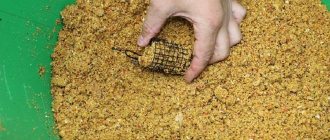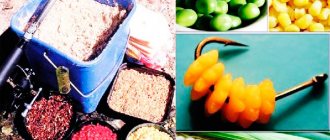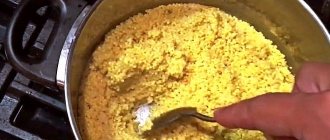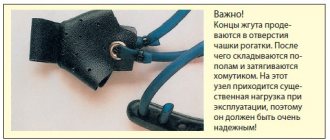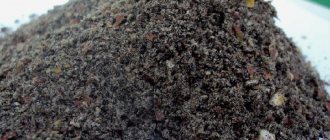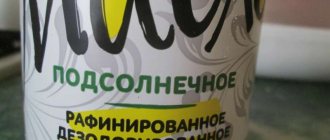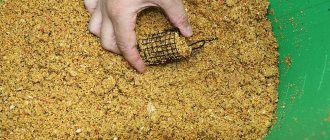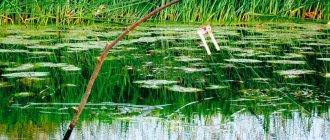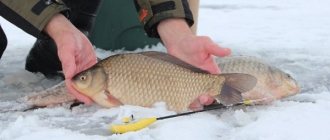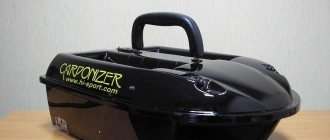Subtleties of cooking
There are many recipes for bait. Moreover, their effectiveness differs depending on the region.
Therefore, to make bait, we will start from the basic principles of preparing bait in the summer on a feeder (for spring and autumn, this option is also suitable, but use less flavoring):
- target fish – carp;
- low cost;
- availability of ingredients;
- quick cooking
The best feeder bait that meets these requirements is prepared from the following ingredients:
- crushed baked goods. You can use almost anything: cookies, gingerbread, breadcrumbs, etc. It should form about half of the composition;
- mixed feed - about 10-20%. If available, bran can be used;
- oat flour (you can, for example, grind rolled oatmeal) – 5-10%;
- semolina – 10%;
- corn (both cereal and flour are suitable) – 5-10%;
- flavoring You can use garlic or dill. Any ready-made flavors on sale will also work.
What is prepared directly on the pond?
All aromatization must be added before pouring the bait feeder into the water. You can also add water to the mixed components while you are directly in the boat. But you should be careful that the mixture is not too moist due to the flavorings and water. You will need to form small balls from the finished bait and check that they do not break on the water. There are special feeder feeders in which bait is used. Its density should be such that it is washed out of the feeder no earlier than after 10-15 minutes.
Another universal recipe for making feeder bait with your own hands in percentages: crackers or gingerbread cookies 40-50%, bran 10-20%, sunflower cake 10-15%, oatmeal 5-10%, semolina 10%, corn flour 5-10% plus ready-made store-bought bait with 10% odor. Semolina, rolled oats, crackers and flour give stickiness. And cereals, bran, cake will give a trail or cloud.
The best ingredients for feeder bait are ground grains: they can make up half or even more of the entire mass. When cooked, this bait perfectly holds the fish in the right place due to its excellent taste. However, you should not make a viscous mess from the bait.
Breadcrumbs and ground biscuits absorb moisture very well, so they can swell greatly in water. This is a plus when there is a small amount of bait. Roasted sunflower seeds are enjoyed by all types of fish. In addition, sunflower seeds have good buoyancy, so they attract fish. In feeder bait, this product can account for up to one third. In addition to sunflower seeds, you can use pumpkin, flax and coriander seeds.
Components such as peanuts are also used in bait mixtures. Usually it is fried and well ground. It has good taste, so when the fish is attracted, peanuts are able to hold it for a while. The groundbait for the feeder may contain 10% or more of peanuts. Bran is a leavening agent in feeder bait. In terms of smell and taste, this is not the most attractive component in fish bait. But bran has excellent buoyancy and can rise from the feeder very quickly.
Powdered milk is also used in feeder bait, but many fishermen note that it can cause the water to become cloudy, which is undesirable. Dry milk that is too fatty makes the fish bait too viscous.
Peas are very often used in feeder bait, as fish love this component. But it should be borne in mind that if the peas are completely boiled, it will muddy the water. But if the peas are cooked so that their grains are intact, then such a product will stop the fish at the point. One way or another, this component improves the taste of the mixture and attracts fish with the smell that it loves so much.
Some professional fishermen use soil in feeder bait. This component is not understandable to everyone. However, it performs the following functions:
- gives the mixture viscosity;
- loosens the mixture;
- makes the bait heavier;
- makes the feeder bait dark;
- creates turbidity that attracts fish.
Some use soil as a component of the mixture during the flow - this saves the remaining valuable components of the mixture.
A non-traditional component of feeder bait is dry ground food for cats or dogs. Some fishermen use canned dog food as an additive to the base. It is enough to remember how such products smell: this bait simply cannot help but attract.
Bird food, egg powder, coconut flakes, semolina can also be used as a basis for preparing bait for the feeder. You just need to add good flavors to these components that will attract fish.
Some people are afraid of overfeeding the fish, but this fear is only valid in quiet pools where there is no current at all. In a river, fish usually move a lot and actively in order to find food, and the current breaks up the mixture. Therefore, the use of large pieces of porridge in bait for the feeder is completely justified.
It is believed that some types of fish can be baited using the base alone. This is true when it comes to roach, for example. But if you catch bream or carp, then they will undoubtedly be attracted to the base, but in order to keep them on the point for some time, you also need to use an additive.
General information about feeder baits
Before I got acquainted with the feeder feeder, I used two methods of feeding fish. The first one is “classic”. A bucket of bait is taken (separately or a mixture of porridge, corn, cake, boiled potatoes, etc.) and delivered to the fishing site from the shore or from a boat. And the second method (no longer similar to feeding, but to attracting fish) is to cover the spring with a combination of cereals, bread, cake and something else sticky and attractive to fish.
Feeder bait is a special thing. When falling to the bottom it should:
- “explode”, creating a cloud or trail of attractively smelling components;
- create a bait spot on the bottom from small and large fractions.
The composition of feeder bait can be divided into two parts: base and additive (filler).
The base includes small components (dry cereals, chalked baked goods (crackers, cookies, biscuits...), grains, grated cake, etc.), and boiled cereals, cereals, corn, etc. can be used as an additive (filler):
| The basis | Additive | Flavors & Enhancers |
| Chalked baked goods, dry cereals, grated cake, chalked seeds (sunflower, coriander, flax, hemp) and so on. | Boiled millet, pearl barley, peas, cereals, corn and so on. | Vanilla, honey, caramel, syrups, coffee, cocoa, chocolate, oils and so on. |
It is clear that our base will gather dust and attract fish, not allowing it to really eat. And the additive, lying on the bottom, and in the case of fishing in the current, slowly rolling and spreading along the bottom, should keep the fish in the bait area.
The preparation of the supplement is simple. It should, firstly, be to the taste of the fish, and, secondly, it should be moderately crumbly, without sticking together in the feeder.
In my experience, the most popular supplements would be:
- not fully cooked millet;
- steamed or slightly undercooked pearl barley;
- boiled bran;
- pea-millet porridge;
- millet-pearl porridge (Salapinka);
- boiled or canned corn;
- a mixture of these components.
If the purpose of fishing is crucian carp or carp , then it is better to use pearl barley (and) or millet; for bream, peas and (or) millet. Boiled bran works well on most "white" fish.
Calculation of the amount of feeder bait
To correctly calculate the required weight, you need, first of all, to know how many hours you plan to spend fishing. You also need to know the capacity of the feeders and the amount of feeding, at least tentatively.
You can calculate it like this. For example, there are two feeders with a capacity of fifty and one hundred grams, one and a half kilograms of feed are taken, and it is expected to spend six hours on fishing.
It takes fifteen casts to feed a hundred-gram feeder. Each cast during feeding takes two minutes for a total of thirty minutes. Five and a half hours left. A fifty-gram feeder makes seven, or even eight, casts per hour. This is about four hundred grams of bait. In five and a half hours it takes two kilograms. Therefore, the final mass is three and a half kilograms.
For the feeder
When fishing with a feeder, it is necessary to mix the bait so that it is not too viscous, otherwise it will not dissolve well, and the angler will not be able to properly feed the point. At the same time, the porridge for fishing on a feeder should not be too crumbly, otherwise the bait will be washed out too quickly, which will generally negate all the efforts of the fisherman.
There are many compounds used by fishermen in their baits. When cooking, various cereals of varying degrees of cooking can be used, as well as dozens of flavoring additives that make the recipes unique.
Barley porridge
One of the popular recipes for feeder baits is pearl barley with sunflower seeds. For the best consistency, it is recommended to use pearl barley with additives for the feeders in order to obtain the optimal consistency. The pearl barley itself may be too crumbly and will have to be firmly compacted into the feeder.
To prepare porridge for fishing on a feeder, you need:
- Pour a glass of pearl barley into the pan.
- Pour five glasses of water over the cereal.
- Add ground sunflower seeds and a small amount of anise seeds to add flavor.
- Place the pan over high heat and cook for 45 minutes.
- Wrap the pan in a blanket so that the porridge cools slowly, and leave in this state for 6 hours.
After cooling, the angler will receive a moderately sticky composition, perfect for fishing on a feeder. This bait is suitable for luring any white fish, but it will be most effective when catching bream and carp.
Hercules porridge
To obtain oatmeal that works effectively as bait, it is also necessary to use additives that improve the viscosity of the mass, otherwise the porridge will be quickly washed out by the current. To prepare rolled oats bait you need:
- Pour the required amount of oatmeal into a colander.
- Pour boiling water over and let the water drain.
- Add crushed feed and actively knead the mixture with your hands.
At the end, the angler will receive a thick, viscous bait, perfect for strong currents.
It is necessary to take into account that it is necessary to add feed depending on the reservoir on which fishing will take place. Compound feed adds viscosity to the bait, so the more it is needed, the stronger the current in the pond.
Millet porridge
The recipe for preparing millet porridge for feeder fishing is somewhat more complicated, but in the fishing community millet is famous for its combination of low price and high efficiency. To prepare millet porridge for the feeder you need:
- Rinse a glass of millet.
- Fill it with plenty of water.
- If desired, add a little sugar and salt, as well as one bay leaf for flavoring.
- Place the resulting mixture over medium heat.
- Cook for approximately 10 minutes, making sure the grains do not become overcooked.
- Remove from heat and drain water.
- Pour the cereal into a frying pan and put on fire.
- Stirring constantly, add semolina in an amount sufficient to obtain the optimal porridge consistency for a particular reservoir.
- As soon as the mass stops sticking to your hands, remove from heat.
- Add a little sunflower oil.
After cooling, the bait is ready for use. This option is most suitable for catching crucian carp and crucian carp. Groundbait with the addition of millet is the most popular among feeder fishermen due to the small size of the grains.
Barley porridge
To prepare bait from a cell, you need:
- Pour boiling water over the barley.
- Wait until she steams.
- Add dry cereal to the steamed grain until a batch structure is obtained, the viscosity and consistency of which is suitable for a particular reservoir.
- In most cases, no flavorings are added to this mixture, since the cereal has a natural odor that has a positive effect on the fish.
Composition requirements
As a rule, a bait mixture consists of at least several main components:
- The base is the part of the bait that should gather the fish in a certain place. The consistency is small dusty particles that form a cloud of tasty turbidity. Its composition usually includes ground cookies and seeds, breadcrumbs, cake or any other component with similar quality characteristics.
- Additive or filler. Designed to hold a school of fish on a feeding table. In terms of consistency, these are larger particles. Various types of porridges (millet, peas, pearl barley) are suitable for these purposes.
- Flavorings give the bait mixture the smell that is most preferable under the established fishing conditions. In spring and autumn, animal odors will be more attractive to fish. The fish’s diet at this time consists of protein baits, so the attractant must be appropriate. But in summer, fruit and berry aromas are preferable.
- Dyes are designed to change the color of bait. In cold water you should try to give the mixture a darker color, while in summer it should be lighter.
- Ground - when fishing on rivers with large currents, it is simply a necessary component. Many fishermen seem to know how to prepare bait, but ignore the ground component. Under no circumstances should this be done. The thing is that the soil makes the bait mixture heavier, allowing it to sink to the bottom and remain at a certain point. Otherwise, all the prepared bait for the feeder will be carried away by the current from the feeding area within a few minutes.
- Molasses is molasses formed during the production of sugar as a by-product. It is widely used among fishermen. Along with its high energy value, it speeds up digestion in fish, thereby forcing it to actively search for food. In addition, its viscous consistency binds bait particles well.
- Bait (attachment) is another extremely important element of bait. Do not forget to add to the bait mixture elements of animal bait (live or canned maggots, bloodworms, pieces of worm) or vegetable bait (grains of canned corn, steamed pearl barley or wheat), similar to those that are attached to the hook.
Be careful when using attractants. Remember: it is better to add less flavoring than to add too much. Otherwise, you may, on the contrary, scare away all the fish. Add in small portions, just before fishing.
Requirements for the mixture and its composition
Based on the data described above, we can draw a conclusion about the mechanical composition of the mixture for feeder fishing. It should contain two fractions:
- fine - to create a continuous carpet;
- large, consisting of feed particles.
In addition, the bait includes a third component - an attractant - to give the mixture an attractive smell. The approximate distribution of ingredients in the composition is as follows:
- base – 60-80%;
- additives – 20-40%;
- aromatics – less than 1%.
Store-bought or homemade bait
You can make complementary food for carp either yourself or buy it in a store. This has become very convenient and greatly simplifies the process of preparing for fishing.
Today, various manufacturers are working on the production of high-quality complementary foods, and at the same time in collaboration with experienced fishermen. Scientists ichthyologists are also involved in this process.
Thanks to common efforts, it is possible to develop a composition of complementary food for fish with an optimal number of components that could completely replace all homemade food.
But since complementary food is intended for very fastidious fish, there are times when carp does not agree to eat what is offered to it.
Therefore, when choosing store-bought complementary foods, you should adhere to the following rules:
- When choosing complementary foods, give preference to more well-known, or better yet, trusted manufacturers. Such feeds, as a rule, are universal and can be used for fishing in almost any body of water. Carp, according to fishermen, reacts quite positively to such bait;
- If you plan to fish on paid ponds or lakes, then before choosing bait yourself, try to find out from the owners or tenants what kind of bait the carp bites best on.
Then the fish will become accustomed to a certain composition and you will be guaranteed a constant catch. Fishermen, as a rule, use either porridge or dry mixtures.
DIY feeder bait: recipe for crucian carp
Crucian carp is a particularly capricious fish, and therefore, in order to find the treasured key to catching crucian carp on a feeder, you will need to make a homemade bait that will cause a strong reaction in the fish, with positive connotations.
A good bait for crucian carp consists of the following ingredients:
- Breadcrumbs - can be used as a base.
- Biscuits and biscuits (flour products perfectly absorb moisture and reward the bait with excellent taste.
- Fresh crumbly flour , since the old one will definitely discourage any desire to enjoy the yummy. The amount of topsoil is 1:3 in relation to the whole bait. (crucian carp will appreciate this ingredient in the bait).
- Wheat bran - approximately 1/10 part.
- Raw ground corn , which gives the bait excellent friability - 1/3 of the total amount of bait.
- The proportion of millet in the bait should not exceed 1/6 , otherwise the substance will stick together on the fingers and will not have the proper friability.
All the above ingredients are thoroughly mixed in one large pan and flavorings are added to make the mixture fragrant and smell good. Ready!
Vitaly Rogozin
Fishing has always been a holiday for me. And whenever possible, I always choose fishing over any other outdoor activity. I'm not a pro, but I'm not a beginner either, I'm a confident amateur. I’ve been fishing for as long as I can remember and I have something to tell you!
Every fisherman dreams of catching a trophy catch. And this can only be done if you have the skills to properly feed fish. Without bait, profitable specimens will simply not pay attention to the tackle and pass by. Therefore, it is so important to feed the most favorable place on the reservoir before each fishing.
Feeder bait differs in many ways from the usual one for float fishing. Basically, its task is not only to attract attention, but also to retain it.
Transportation and use of bait
When “conjuring” the composition of bait, it is important to take into account one rule: it is better to make a one-time batch of 10 kg of ingredients in order to stock up on bait for future use. It is better to package the resulting viscous composition in bags with a capacity of 1-2 kg
The bait should be mixed with river water in which the fish live, because such water is native to the fish. After moistening the bait, wait about 20 minutes so that each piece of food absorbs the liquid.
After this, you need to thoroughly mix the bait and determine the degree of its viscosity by eye, and if you want to determine more accurately, then you need to fill the feeder with the mixture and throw it not far from the fisherman.
Emptying the feeder in 5-10 minutes indicates that you have done everything correctly and then you can start fishing.
Of course, store-bought baits cannot be compared in quality and taste to those prepared at home, with the warmth and care put into the preparation process. You can only use fresh, high-quality ingredients of the highest grade, and then the fish will thank you with a good bite.
Bait for bream on the feeder
The bait is usually prepared in dry form and in large quantities, so prepare a large container in which you will mix the ingredients, as well as containers (or bags) in which the dry mixture will be stored.
There are no difficulties in production, we just mix all the components. There are many recipes for preparing bait for a feeder with your own hands; for example, let’s look at one of them:
- breadcrumbs 1.5 kg;
- ground biscuits 1 kg;
- oat flour 1 kg;
- corn grits 1 kg;
- oat flakes 0.5 kg;
- roasted seeds 0.3 kg;
- as a flavoring, cinnamon 60 g and cocoa 0.25 kg.
Composition of universal bait for feeder fishing:
- breadcrumbs – 2 kg;
- bran – 0.5 kg;
- makukha – 0.5 kg;
- rolled oats porridge – 0.4 kg;
- semolina – 0.3 kg;
- corn flour/cereals – 0.3 kg;
- purchased bait (optional) – 0.4-1 kg.
Recipe for a summer river
- sunflower seed cake - 400 g. Cake is the main component of bait. In addition to sunflower seed cake, you can use pumpkin, hemp, rapeseed, and flaxseed cake;
- bread crumbs or bread crumbs - 200 g. You can use different bread crumbs, depending on the type of bottom. So, on a muddy bottom, bait with rye crackers will not contrast, but on sandy areas, wheat crackers are better suited;
- ground peas - 400 g;
- boiled oat flakes - 400 g;
- coriander - 6 teaspoons;
- clay.
Recipe for spring
- millet porridge - 200 g;
- feed bloodworm - 6 matchboxes;
- sunflower seed cake - 200 g;
- bran - 200 g;
- powdered milk – 50 g;
- river sand and clay.
Recipe for autumn when fishing in the current
- bread crumbs/bread crumbs - 200 g;
- lard - 80 g;
- sunflower seed cake - 200 g;
- rice porridge - 200 g;
- bran - 200 g;
- bloodworm - 4 matchboxes;
- clay.
How to make bait for bream on a feeder
Complementary feeding for bream requires the presence of a large fraction, in the form of pearl barley, peas or another type of porridge. Bream lives in schools, so complementary food without a sufficient amount of large components will be quickly eaten, and the angler will not feel the effect of complementary feeding.
It is recommended to use components that are present in the bait. For example, if there are maggots in the bait, then it would be nice to add them to the complementary food. This can increase your catch.
As a basis for bait, 2 combinations worked well: millet porridge, pearl barley, millet porridge and boiled peas.
Cook the peas until they become soft, then add the millet. Bring the porridge to a boil, remove from the stove, and wrap it in a warm blanket overnight.
How much porridge should I add to the bait?
It all depends on the time of year, the presence or absence of a current, and the number of fish in the reservoir. For example, if the current is weak, there is a chance that you will overfeed the fish and it will no longer bite the hook, but this situation is rare.
Therefore, at least 20 percent of the total weight of the bait, and in some cases 50, should be an additive, most often it is half-baked porridge. The porridge will keep the fish in one place longer, which will significantly increase the chances of successful fishing.
Recipe No. 1. Summer, closed reservoir without current
Quick bait. The first two seasons of feeder fishing I used only this:
- 400 gr. rolled oats flakes;
- 400 gr. breadcrumbs;
- 200 gr. canned corn;
- 5-10 gr. vanillin;
- 20-30 gr. cinnamon.
This bait is very convenient because it does not require the preparation of ingredients and everything can be bought on the way to fishing in any available store. It creates turbidity in the water very well, but still it does not attract large fish so well, which is why I added grains to the new composition.
The composition can be changed as you like, there can be countless components, I choose what is within walking distance and does not require large expenses. Now you can buy any bait with any aromas and tastes in every fishing store, but you must agree: it’s much nicer to show off a worthy catch and at the same time add that the bait was homemade.
How to choose a place for bait (bait)
Even if the place is standard and not entirely suitable for fishing, bait can make it very productive. The main thing is that this place on the river does not look like a straight pipe. This is a completely unpromising place. It is best to choose a section of the river where the current begins to swirl in the opposite direction. It is at the border between the reverse flow and the core jet that you should choose, even if there is no clearly defined edge or slope onto the pit.
An attractive and very promising place for bait is a tree lying in the river, especially if it is still alive and has foliage or needles on it. This happens when the spring current washes away the shore and the tree falls into the water, while being held by its roots in the steep bank. Such a tree already initially serves as a haven for insects and, therefore, is a natural feeder, where fallen beetles and larvae are constantly swirling in the stream, among which bark beetles are often found that are appetizing to fish. In such a place, even if you are not going to fish from a boat on the side bottom, you can hang a mesh feeder on a strong nylon cord. Moreover, a three-dimensional vegetable net, in which potatoes are usually sold, can also serve this purpose. If you fill it with breadcrumbs and dense porridge, then such a feeder will attract fish for several days without any of your participation. That is, there is no need to throw bait in the same place every day. as an aromatic component that will release the scent for a long time.
Homemade bait recipes
For bream you need to prepare a lot of bait. You should always have some supply with you, since fishing can be activated and you will have to feed the future trophy with something. When fishing with a donk and a feeder, use feeder weights, and when fishing with a float, make balls.
In specialized stores, ready-made bait is sold, but it is not cheap, and given the fact that you need a lot of it, the pleasure can hit your pocket. The simplest and cheapest option is to prepare bait at home.
The best ways to cook homemade catch bait:
Excellent bait, attracts bream during feeder fishing. It works ideally in the fall (it’s convenient to fill the feeder weight with donks) and in the winter when fishing from ice.
Recipe No. 1:
- Boil oatmeal and millet over low heat. During cooking, you need to make sure that the mixture does not burn, as there will be an unpleasant smell.
- Further preparation continues at the fishing site.
- Clay or sand is added to the porridge so that the cereal holds its shape.
- Breadcrumbs, sunflower and hemp seeds, vanilla extract, and your choice of bloodworm or maggot are added to the finished mixture.
- Small balls - 5-6 pieces - are molded from the resulting mixture and thrown into the water.
Recipe No. 2:
Super bait, works well as bait. You can prepare the mixture with your own hands even on the day of fishing; it is ready in 1 hour.
- The bait is done immediately before fishing.
- Mix bran, sunflower cake, corn sticks or flakes, coffee drink, bloodworms and maggots in a bowl.
- Water from a pond and clay are added to this mixture, and everything is kneaded until it becomes a thick dough. You can let the bait sit for a few minutes.
- Then the balls are molded and thrown into the water. While fishing, you can make very small balls and throw them into the water to keep the fish in place.
Recipe No. 3:
An old grandfather's bait that makes bream bite even in ponds with no current.
- On the shore of the reservoir, the following ingredients are mixed in one bowl: steamed peas, bran, flax seeds (fried), egg powder, fresh grated beets, worms, maggots, clay.
- After kneading, balls are made and sent into the water.
Experienced fishermen always experiment with bream food. But there are universal mixtures that work under almost any conditions.
Recipe:
- In a saucepan you need to boil 3-3.3 cups of water.
- Add 2.5 cups of pearl barley to boiling water. It must be cooked until half cooked.
- After the pearl barley swells, millet is added.
- Vanilla and sunflower oil (unrefined) are used to add flavor.
- The porridge should be cooked until most of the water has evaporated.
- After this, turn off the pan and cover with a lid and leave for 40-45 minutes so that the remaining water is absorbed into the cereal.
- After this time, the porridge must be transferred to another container.
- Add 3 cups each of barley and corn to the warm mixture.
- At the fishing spot, you can already add clay and water for better mixing.
Adviсe:
- Barley and millet groats cannot be replaced with anything.
- Instead of barley and corn grits, you can use crackers, cake, and store-bought bait.
Full of life
Very often, especially when fishing in shallows, the problem becomes the lively bite of small things, which are attracted to the bait by the plant bait “dusting” in the water.
To cut off small things, I suggest using special closed feeders, inside of which only live food is placed. Most often, this technique helps to selectively catch larger specimens. In my collection there are several varieties of such feeders, each of them is used for a specific type of filler. The smaller the size of the larvae or worms stuffed into the feeder, the smaller the diameter of the holes should be. The number of holes greatly influences the rate at which the larvae emerge, so feeders whose diameter and number of holes can be adjusted are very convenient. The main objects that can be seduced by such feeders are roach, bream, ide and chub.
Good results can be achieved with a combined leash. To do this, take about a meter of thick fluorocarbon fishing line with a diameter of 0.18-0.2 mm, to which 8-12 cm of fishing line with a thickness of 0.1-0.12 mm is tied. A thick line sinks slowly in the water, which provides the maggot with the necessary diving speed, and the fish is not afraid of a thin line and confidently attacks the bait on the hook.
Composition of feeder bait
Bright fruity smells are suitable in the summer, while in winter they will, on the contrary, scare off most fish. The following can be used as flavorings:
- coriander. It is advisable to grind fresh coriander into bait on the day of fishing;
- Dill seeds. A few teaspoons are enough;
- caraway;
- artificial flavors with a strong fruity smell.
The bait is prepared in advance in large volumes, without adding liquid. Such dry preparations are packaged in bags where they are stored, awaiting the day of fishing. The bags hold approximately 1.5 kg, and several of these bags will be enough for full-fledged feeder fishing.
Already in place, with the addition of water from the reservoir, we mix the bait. After mixing, give the bait time to absorb moisture and check the viscosity. If the bait is too viscous, then add water.
Just in case, always leave a little dry mixture so that you can easily adjust the viscosity of the bait.
The bait is equipped with a feeder feeder. Each angler has his own preferences, but the most common are spring feeders and “method” feeders.
This type of fish eagerly consumes animal food, but depending on the time of year, its preferences change. When the water becomes cold, bream switches almost entirely to animal food, and in the summer, when the temperature of the surrounding liquid is much higher, it happily consumes plant food.
Knowing these features of the diet of the fish species in question, you can formulate rules for selecting animal bait by season:
- winter, late autumn, early spring (cold water) - chopped worms, bloodworms;
- spring, summer, early autumn (warm water) – maggot.
Experienced fishermen recommend making one bait, packaging it into portions and using it in the future. Almost all recipes are designed for 1 kg of total weight.
When mixing, it is best to use native water for fish from a local reservoir. It is necessary to moisten the mass and be sure to wait for 25-30 minutes so that each part of the mass absorbs water and is saturated with the smell.
To make sure that the recipes and recommendations are followed correctly, you can try putting the prepared mixture in the feeder and making a small cast. If the feeder is empty in 10-15 minutes, the recipe is a success! This will be the starting point, you can start fishing!
Flavorings for bait
Bright fruity smells are suitable in the summer, while in winter they will, on the contrary, scare off most fish. The following can be used as flavorings:
- coriander. It is advisable to grind fresh coriander into bait on the day of fishing;
- Dill seeds. A few teaspoons are enough;
- caraway;
- artificial flavors with a strong fruity smell.
Nowadays, specialized stores have a very large selection of “sweet” flavors. They can also be made at home. For this, ordinary fruit syrups and glycerin are used.
Recommendations for choosing bait
An adult carp is quite large. Therefore, for any fisherman it is always a desired trophy. Catching carp in a pond is very difficult. This inhabitant of ponds and lakes is very smart and careful. Therefore, both beginners and professional fishermen want to get such fish.
To fish for carp, you need high-quality tackle and the right bait. However, this is often not enough. You need to know everything about the habits of fish, taste preferences and activity in different seasons of the year. A well-chosen bait increases the likelihood of successful fishing several times.
It is worth noting that the taste needs of carp are constantly changing. This is due to a large number of reasons: season of the year, water heating, air temperature. Much depends on the food supply of the reservoir. If the bait performed well on one pond, then on another it will be useless. The carp will completely ignore it. Not everyone knows, but each body of water has its own flora and fauna, which is different from others. Therefore, fish behave differently everywhere. If on one pond there is a good bite early in the morning, then on another the fish may be actively caught during the day.
There are several types of bait that fishermen use to attract carp. They are divided:
- Baits with plant composition.
- Balls of a special type.
- Baits with various animal additives.
Everyone knows plant ingredients. These include bread, corn, cottage cheese, boiled potatoes, pearl barley, and millet. Baits of animal origin include maggots, dung worms, bark beetles, dragonfly and caddisfly larvae, and pupae. All these baits showed their best performance when fishing for carp.
Special baits include boiled. This product is manufactured in the form of balls. It is popular with fishermen. In terms of its effectiveness, this type of bait very often surpasses its competitors of plant and animal origin.
A little about the boiled bait
Currently, boiled is used to catch carp. This bait is considered one of the best. It consists of balls consisting of a special composition. They add aromatic oils, the smell of which attracts fish. This product has one more feature. The balls do not get wet at all in water. This gives the fisherman a great advantage. There is no need to constantly throw back the bottom tackle, since the homemade bait gets wet and loses its properties. And this process is very tedious and time-consuming.
The balls range in size from 0.5 to 3 cm. However, professional fishermen usually buy products with a diameter greater than 1 cm. In addition, small round balls become easy prey for frivolous fish. This fact disappoints many, since all anglers want to catch a big trophy. Balls have different buoyancy. Some may drown, while others remain on the surface of the reservoir. Also roundels come in different colors. There have been cases when, having changed the shade of the bait, the fish began to actively bite.
There is a wide range of ball baits on the market. However, the fisherman needs to know which scent is best for fishing. Depending on the time of year, carp prefer the following smells:
In the spring, the carp family bites better on bait with the taste of crustaceans and mollusks. After winter hibernation, a real glutton opens up. Therefore, the high nutritional value of this bait attracts better. In the summer, carp have enough food, especially if there are a lot of reeds on the pond. Therefore, you can lure it exclusively with exotic smells. In this case, you can use the aroma of fruit or caramel. In autumn, fish should accumulate fat. She needs this for a comfortable winter. Therefore, during this period, baits with the smell of crustaceans are suitable. Winter time is characterized by reduced activity of carp. He moves little and it is not so easy to lure him out of the hole. Therefore, you can use baits with strong and pungent odors.
When purchasing boiled, you need to pay attention to the diameter of the ball and its buoyancy ability. Some baits sink to the bottom, while others remain afloat
When fishing, you need to take into account the peculiarities of the reservoir. Therefore, it is better to have different types of bait in your arsenal.
